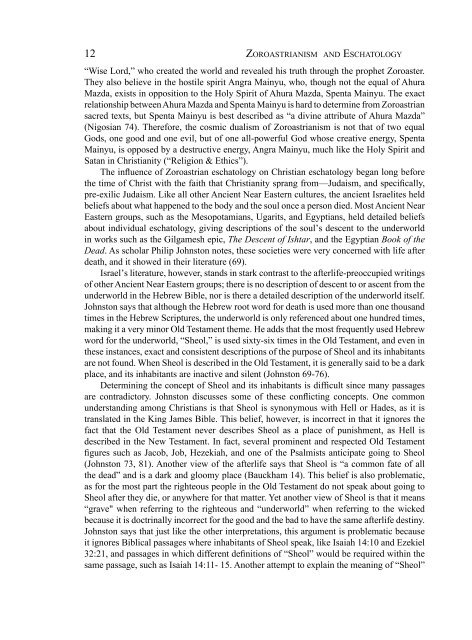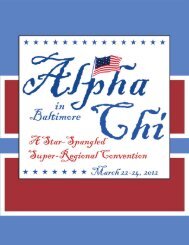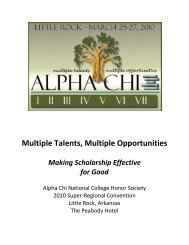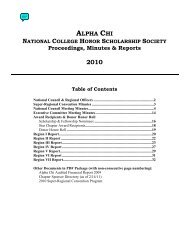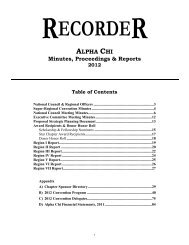Vol. 52, No. 1, 2009 - Alpha Chi
Vol. 52, No. 1, 2009 - Alpha Chi
Vol. 52, No. 1, 2009 - Alpha Chi
You also want an ePaper? Increase the reach of your titles
YUMPU automatically turns print PDFs into web optimized ePapers that Google loves.
12 Zo r o a s t r i a n i s m a n d Es c h at o l o g y<br />
“Wise Lord,” who created the world and revealed his truth through the prophet Zoroaster.<br />
They also believe in the hostile spirit Angra Mainyu, who, though not the equal of Ahura<br />
Mazda, exists in opposition to the Holy Spirit of Ahura Mazda, Spenta Mainyu. The exact<br />
relationship between Ahura Mazda and Spenta Mainyu is hard to determine from Zoroastrian<br />
sacred texts, but Spenta Mainyu is best described as “a divine attribute of Ahura Mazda”<br />
(Nigosian 74). Therefore, the cosmic dualism of Zoroastrianism is not that of two equal<br />
Gods, one good and one evil, but of one all-powerful God whose creative energy, Spenta<br />
Mainyu, is opposed by a destructive energy, Angra Mainyu, much like the Holy Spirit and<br />
Satan in Christianity (“Religion & Ethics”).<br />
The influence of Zoroastrian eschatology on Christian eschatology began long before<br />
the time of Christ with the faith that Christianity sprang from—Judaism, and specifically,<br />
pre-exilic Judaism. Like all other Ancient Near Eastern cultures, the ancient Israelites held<br />
beliefs about what happened to the body and the soul once a person died. Most Ancient Near<br />
Eastern groups, such as the Mesopotamians, Ugarits, and Egyptians, held detailed beliefs<br />
about individual eschatology, giving descriptions of the soul’s descent to the underworld<br />
in works such as the Gilgamesh epic, The Descent of Ishtar, and the Egyptian Book of the<br />
Dead. As scholar Philip Johnston notes, these societies were very concerned with life after<br />
death, and it showed in their literature (69).<br />
Israel’s literature, however, stands in stark contrast to the afterlife-preoccupied writings<br />
of other Ancient Near Eastern groups; there is no description of descent to or ascent from the<br />
underworld in the Hebrew Bible, nor is there a detailed description of the underworld itself.<br />
Johnston says that although the Hebrew root word for death is used more than one thousand<br />
times in the Hebrew Scriptures, the underworld is only referenced about one hundred times,<br />
making it a very minor Old Testament theme. He adds that the most frequently used Hebrew<br />
word for the underworld, “Sheol,” is used sixty-six times in the Old Testament, and even in<br />
these instances, exact and consistent descriptions of the purpose of Sheol and its inhabitants<br />
are not found. When Sheol is described in the Old Testament, it is generally said to be a dark<br />
place, and its inhabitants are inactive and silent (Johnston 69-76).<br />
Determining the concept of Sheol and its inhabitants is difficult since many passages<br />
are contradictory. Johnston discusses some of these conflicting concepts. One common<br />
understanding among Christians is that Sheol is synonymous with Hell or Hades, as it is<br />
translated in the King James Bible. This belief, however, is incorrect in that it ignores the<br />
fact that the Old Testament never describes Sheol as a place of punishment, as Hell is<br />
described in the New Testament. In fact, several prominent and respected Old Testament<br />
figures such as Jacob, Job, Hezekiah, and one of the Psalmists anticipate going to Sheol<br />
(Johnston 73, 81). Another view of the afterlife says that Sheol is “a common fate of all<br />
the dead” and is a dark and gloomy place (Bauckham 14). This belief is also problematic,<br />
as for the most part the righteous people in the Old Testament do not speak about going to<br />
Sheol after they die, or anywhere for that matter. Yet another view of Sheol is that it means<br />
“grave" when referring to the righteous and “underworld” when referring to the wicked<br />
because it is doctrinally incorrect for the good and the bad to have the same afterlife destiny.<br />
Johnston says that just like the other interpretations, this argument is problematic because<br />
it ignores Biblical passages where inhabitants of Sheol speak, like Isaiah 14:10 and Ezekiel<br />
32:21, and passages in which different definitions of “Sheol” would be required within the<br />
same passage, such as Isaiah 14:11- 15. Another attempt to explain the meaning of “Sheol”


